Back to page 1
The Exterior

Let’s turn our focus now to the stadium itself — first examining the outside of the facility, then the interior.
Aside from the Friends of Hinchliffe Stadium and the governmental entities involved, it took quite a few private firms to pull off this project. There were two developers brought into this: RPM Development Group and BAW, the latter run by Baye Adofo Wilson. LoPinto refers to him as the “face of this project.” Mayor Sayegh says, “I sometimes refer to Hinchliffe Stadium as the House That Baye Built.”
The architecture firm was Clarke Caton Hintz out of Trenton. “They’ve been working in Jersey for along time and have done a host of historic rehabilitation work,” says Joe Postelli, Senior VP at RPM. He adds that “we also had the help of a very talented consultant named Ulana Zakalak. She’s worked with us on a bunch of historic restoration projects that are subject to Secretary of the Interior standards for rehabilitation.”
Acting as the general contractor on the job was Pike Construction of Paterson. In fact, all of the vendors who worked on the Hinchliffe project are from New Jersey.
As this Google Street Maps photo from July 2013 shows, these vendors were walking into a mess.

RPM came onboard after the initial rebuilding of the northwest exterior wall that used matching funds from the New Jersey Historic Trust. While that was largely a test project to prove what could be done, Postelli said it was very important for the State to “become familiar with the site and the means and methods that we could use elsewhere on the site.”

When Hinchliffe was originally designed, the engineers and designers didn’t want plain cement walls, and they certainly didn’t want chain link fences that people could look through and not pay for a ticket. The walls have tiles and medallions embedded every so many feet, and these have been beautifully restored as part of the renovation. The scene above, by the way, is the exterior wall along Liberty Street. This was the first renovation work done on the stadium, using the matching grant money from the state.

The entryway used by the Jackals is on the eastern end of the Liberty Street exterior wall (see above). This is where you’ll find the ticket windows, right next door to the beautiful new senior-housing structure.
And finally, this is what the exterior looks like from the National Park at the top of the Great Falls. This will house the food court and the Negro Leagues museum (more on these in the next section).

Everything about the exterior looks a lot better than in July of 2013, doesn’t it?
The Design

Mayor Sayegh told me that the original concept for Hinchliffe Stadium was to resemble the Circus Maximus in ancient Rome. Now mostly rubble, it was a gleaming example of Roman architecture, where up to 150,000 people could watch chariot races in a mammoth, oval stadium.
I can picture what the mayor is talking about.
What did it take to recapture Hinchliffe’s former glory … even if it wasn’t as elaborate as the Circus Maximus?
I asked Portelli whether working on the stadium required simply making repairs or did they have to demolish everything there and rebuild it. “It was a mix of both,” he replied. “For example, in the corners in order to create code-compliant bathrooms, we had to excavate the mezzanines and build them back with the bathrooms underneath. The six sections above the locker room were brand new (concrete) pours. The other 15 sections were a mix of repairing and restoring.”
And because the stadium had been named a Historic Landmark, all of the work had to use materials and techniques to produce a look that remained true to the original construction — and remember that took place 90 years ago!
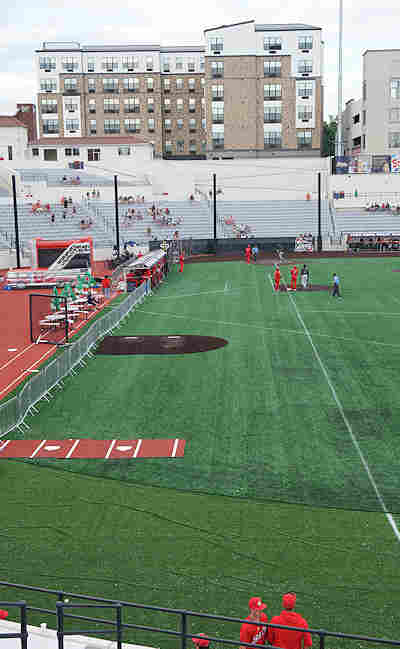 For instance, there are no fixed seats in the stadium. Just long concrete benches for fans to sit on, because that’s the way it was in 1932 … and in ancient Rome for that matter. Further, photos of Negro League and other baseball games in the middle of the 20th Century showed a canopy or roof covering some of the stands — no doubt delighting attendees at day games in the summer. There’s no such thing now, just acres of exposed benches. So why no covering? “It was not original,” explained Portelli. “That was a key part of the scope. For historic tax-credit approval, you have to retain as many original elements as you can.”
For instance, there are no fixed seats in the stadium. Just long concrete benches for fans to sit on, because that’s the way it was in 1932 … and in ancient Rome for that matter. Further, photos of Negro League and other baseball games in the middle of the 20th Century showed a canopy or roof covering some of the stands — no doubt delighting attendees at day games in the summer. There’s no such thing now, just acres of exposed benches. So why no covering? “It was not original,” explained Portelli. “That was a key part of the scope. For historic tax-credit approval, you have to retain as many original elements as you can.”
There are some elements from 1932 that simply can’t be replicated, like bathrooms that don’t meet today’s building code or the fact that there were no lights. Further, the field was grass, while today it only makes sense to use an artificial surface. This one is made by FieldTurf. I was thankful for it the evening I attended a Jackals game. In the 5th inning, the skies opened up with an absolute deluge. Seemingly minutes after the last drop fell, the game resumed. That is a really nice playing surface.
The orientation and dimensions of the playing field need some explanation. As my pictures show, there is a lot of space between the first-base line and the stands, because the third-base line runs parallel to the front of the stands in this oval-shaped stadium. This isn’t an attractive look — and isn’t even the way the field was oriented for baseball during the Negro League days. Back then, home plate was in the center of the endzone (when football was played here). If you’ve ever seen pictures from New York’s Polo Grounds, that’s the way the field was there — short distances down the foul lines, but a really long way to dead center field. That was common in stadiums 100+ years ago, particularly in the Midwest.
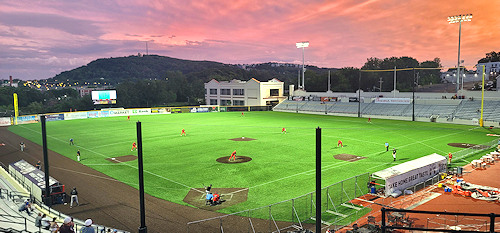
Personally, I wish they would’ve kept the orientation from Negro League days. If MLB does bring a game here, I hope they’ll revert to that orientation to give the contest a real Negro League feel.
Eventually, they shifted the playing field to the orientation in use today, which makes for a very short right-field wall — reminiscent of left field when the Dodgers used to play in the LA Coliseum before Dodger Stadium was built. The sign by the right-field foul pole says it’s 327 feet from home plate — but I’m here to tell you that this isn’t even remotely possible. I would estimate it’s more like 275 feet. They do compensate for this short distance by having a 40-foot-tall net there (nicknamed the Maple Street Monster, in honor of the street that runs along that edge of the stadium), and a batter has to hit it over that “monster” for it to be a home run. The outfield net from right-center to center is 12-feet tall, and it’s about seven-feet tall from center field around to the left-field foul pole. Listed dimensions are 385 to center and 320 down the left-field line.
By the way, when the Jackals played their first-ever game in Hinchliffe, there were ten home runs hit that day. And as I write this review, the team is averaging 2.2 homers and 7.6 runs per home game and only 1.5 HRs and 6.4 runs on the road. So, yeah, it’s pretty much a hitter’s park.
And if you take a close look at the pictures, you’ll notice there is a monstrously large foul territory on both sides of fair territory. Hey, you have to give the pitchers some kind of advantage when it’s so easy to hit home runs here!
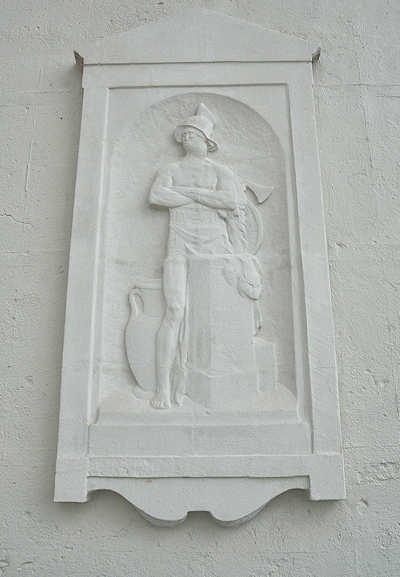 There’s a really nice touch on an interior wall near the main entrance. It’s a frieze called The Gladiator (see photo) by Paterson artist Gaetano Federici. He created so many statues and sculptures for public buildings in town that he became known as the “sculptor laureate of Paterson.” He made three such friezes for Hinchliffe when it was originally built, with the other two being retrieved before the stadium fell into disrepair and placed on display in the Paterson Museum. Make sure you admire The Gladiator when you come to Hinchliffe.
There’s a really nice touch on an interior wall near the main entrance. It’s a frieze called The Gladiator (see photo) by Paterson artist Gaetano Federici. He created so many statues and sculptures for public buildings in town that he became known as the “sculptor laureate of Paterson.” He made three such friezes for Hinchliffe when it was originally built, with the other two being retrieved before the stadium fell into disrepair and placed on display in the Paterson Museum. Make sure you admire The Gladiator when you come to Hinchliffe.
The original stadium had a pressbox on the west side on what would have been roughly the 50 yard line for football. Today’s pressbox is directly across the field on the east side, which unfortunately places it pretty far from the pitcher and batter for baseball.
If you walk up the hill toward the stadium from the Great Falls, the first thing you’ll notice is a sparkling new — but unoccupied — two story building with lots of windows to take in the spectacular view of the National Park. Mayor Sayegh was adamant about wanting this structure to be part of the $103 million master plan. The first floor will have a food court of sorts, which the Mayor envisions as providing visitors with “a taste of Paterson.” This will be nice, since the concession offerings in the park aren’t very robust. The mayor also said he can envision a restaurant being built on the roof of this building “for a really spectacular view of the falls.”
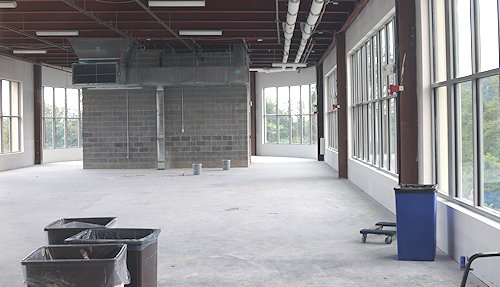
The second floor (photo above) will contain a museum that is being planned and curated by Montclair State University — which is kind of ironic since this ballpark stole the Jackals who played on their campus for 25 years.
The museum will honor the Negro Leagues, and act as sort of an extension of the Negro League Baseball Museum in Kansas City. It will also feature Paterson’s own Larry Doby.
Kendrick doesn’t view this as competition. “We want everyone to come to the National Negro Leagues Baseball Museum (in Kansas City) and experience it, but we know that that’s not possible,” he explained. “We also understand that as much as we would love to be able to share every city’s complete history as it relates to the Negro Leagues, we just simply do not have the space to do it here. So these ancillary opportunities like this one being created in Paterson are a wonderful extension of the work that we’re doing in Kansas City.
“That region’s Black baseball history deserves to be told.”
The Essentials
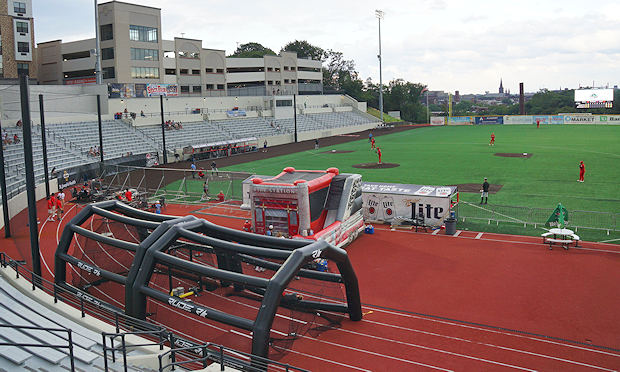
Kendrick has great insight into the exceptional value in preserving the history of Hinchliffe Stadium. In fact, he traveled to Paterson to attend the ceremony when the facility was designated a National Historic Landmark.
“We should preserve these landmarks,” he explained. “So often they do face the wrecking ball and they’re demolished. And, yeah, you could rebuild them, but you can’t rebuild history. In renovating, the ghosts of all of those players are still there. So I’m just thrilled that they went the route of renovating the stadium so that it would maintain that true spirit and essence of what the Negro Leagues represented when the players took the field there.”
When Portelli attended a Jackals game, he told me he overheard someone say “It’s just like how I remember it.”
That was certainly the goal, to bring it back to its past glory.
Now that it’s there and baseball is being played, it’s up to us to go to Paterson and honor the Negro League history and support the team that’s playing there.
So what’s it like to attend a Jackals’ game at Hinchliffe? First of all, planning is the key. If you’re driving and you want to park in the shiny new parking garage adjacent to the stadium, I’m told you have to register on a City of Paterson website before you arrive, because an attendant won’t let you in if you’re not on a list. When you register, the cost to park is $15.
If you haven’t registered in advance, you’ll most likely need to hunt around the neighborhood to find a space on the street.
If you do park in the garage, take the elevator up to the roof for a beautiful, panoramic view of the stadium. The photo at the top of The Design section was taken there. The view from dead center field is below.

And like parking, $15 is also the cost of a ticket to a game. There are no luxury boxes or all-you-can-eat party decks. You pay $15 for a general-admission ticket, then you can sit wherever you want. And if it’s a day game, keep in mind there is no overhang or roof to provide any shade, so prepare accordingly.
If you have attended Jackals games at Yogi Berra Stadium, you will find the surroundings and features at Hinchliffe to be fairly, um, spartan. Truly, baseball is the center of attention here. And when the food court and museum are completed, you’ll have a lot more to munch on and to keep you occupied.
 There is only one concession stand here, and it’s located on the first-base side. It’s operated by a local minority-owned operation called Shekinah Group.
There is only one concession stand here, and it’s located on the first-base side. It’s operated by a local minority-owned operation called Shekinah Group.
As you would expect, they offer hot dogs ($5) and burgers ($6.50), and they are grilled right next to the concession stand, so they are quite fresh, if a bit overcooked. By far, my favorite item on the menu were the empanadas ($6.50). They come stuffed with chicken, beef or cheese, and they were deliciously flaky and fantastic (see photo).
Coke products are $5.25, and there is an assortment of beers for $6.50.
While all of this is fine, I can’t wait for the food court to open.
For kids, there was an inflatable bounce house, but it’s not where you typically find it at a ballpark. At Hinchliffe, it’s right behind the home dugout because there is such a wide expanse between the field of play and the bowl end of the stadium. This is also where the inflatable batting cage is kept … and to be honest, it makes for a junky look. But, honestly, where else are they going to store it?
Also for kids is a miniature ball field right on the playing surface near the right field corner. This is certainly an odd location, but again, where else would the Jackals put this?
There is an enclosed store near the main entrance. For an independent league team, the selection was reasonable, as were the prices. Both adult and kids T-shirts were $18-20, with a 3/4 sleeve shirt for $25. Fitted caps were $35-42. There was also a knockout New York Black Yankees jersey for $100 (see photo below).
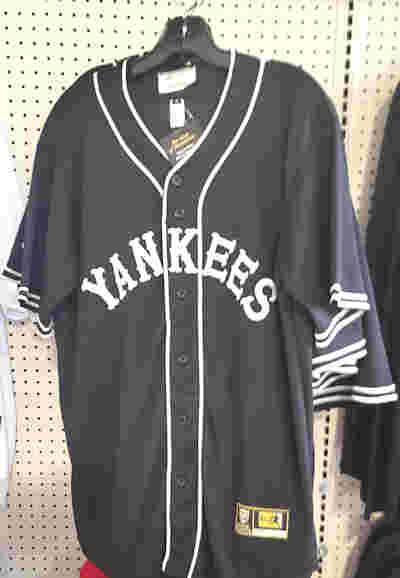 One carryover from games at Yogi Berra Stadium is Scott Freier of Bloomfield, New Jersey. He’s a season-ticket holder who brings his trumpet to every game, doing the familiar “charge” pattern and playing other musical phrases. Since there’s not an organist, he provides a much-welcomed bit of musical accompaniment to the games. He is not a member of the staff or doing this as an extension of the team. He does it because he loves doing it. Thank him if you come to a game.
One carryover from games at Yogi Berra Stadium is Scott Freier of Bloomfield, New Jersey. He’s a season-ticket holder who brings his trumpet to every game, doing the familiar “charge” pattern and playing other musical phrases. Since there’s not an organist, he provides a much-welcomed bit of musical accompaniment to the games. He is not a member of the staff or doing this as an extension of the team. He does it because he loves doing it. Thank him if you come to a game.
One noticeable expenditure of funds on the rebuilding of Hinchliffe is the public-address system. The speakers are scattered around the seating bowl … and they are *deafening.* Every time there was an announcement or music was played, it just about blew out my eardrums. In fact, I found an older fan huddled against the concrete in the farthest corner of the stadium watching the game. His name is Ed Papay. I struck up a conversation with him, and he explained that this is always where he sits “to escape the sound. I used to attend 80% of the home games at Yogi Berra, but only about 30% here even though it isn’t much farther to come here. I have two friends of mine who don’t come here no more because of the speakers.
“I’d come to more games if the speakers weren’t so loud.”
Since this was also my experience, I then reported this to the press box where the PA is controlled. Brian LoPinto told me that since that day, he’s noticed the PA is less deafening. I hope so.
I asked Papay if he had any reservations about coming to this neighborhood for games. “Before I started coming here, I was hearing about how rough Paterson was. Honestly, I’ve had no problem here.” Freier confirmed that he hasn’t had any bad experiences either.
I think this is an important point. I noticed that attendance at Jackals games is down in 2023. In fact, they are the only Frontier League team averaging under 1,000 fans per home game. I asked Reed Keller of the team’s front office about this. “A big portion of our fan base has a false assumption about the area of the new park,” he replied. “We need to convince our fans that Paterson is improving.
“Every game this season has gone off without a hitch safety-wise.”
Regardless of the size of the crowds — and I sincerely hope they get larger — I commend the Jackals for making this move. A venue with this much historic significance deserves to have a full-time tenant.
Summary

Now that baseball is once again happening at Hinchliffe, Brain LoPinto attends New Jersey Jackals games regularly. Every time the 45-year-old videographer goes, he insists on parking by the store over which he grew up. “Walking that two blocks to Hinchliffe reminds me of just what a treasure I had so close by, but wasn’t able to attend. I wish a minor league team was at Hinchliffe when I lived here.”
Thanks to the hard work of LoPinto — and the citizens of Paterson and of the State of New Jersey — this treasure has been saved from certain demolition. Now we can all visit it to honor the incredible athletes who played in the Negro Leagues. And we should never forget the injustices that made it necessary for separate leagues to exist since Black Americans were barred from playing in Major League Baseball.
And MLB should honor this memory by bringing a “Field of Dreams” game here.
Really soon.
Provide a comment below with your thoughts about Hinchliffe Stadium or this review.
Loved this article! How about initiating a social network movement to bring A FIELD OF DREAMS MLB game here to honor Hinchliffe Stadium, Larry Doby & the Negro Leagues?
As you can tell from my write-up, I am a strong proponent of this. I’m doing some things behind the scenes to see if I can get some traction on this. Thanks for commenting!!
Hi Joe. I loved the article! My uncle played for the NY Cubans in the 1930s and 40s. His name was Horacio “Rabbit” Martinez. He retired 1947 after they won the Negro League World Series and became a scout for the NY Giants. I’m making a documentary and was wondering if you knew anything about him you could share or could recommend who to talk to or where to find vintage photos and videos? I’m already planning to reach out to look to but I thought I’d ask you after reading this great article. Thanks for helping to keep these important memories alive.
Thanks for reading my ballpark review. I don’t have access to any insight into your uncle. I would suggest contacting the Negro League Baseball Museum in KC or the Friends of Hinchliffe Stadium. Maybe one of them could point you in the right direction. Good luck!!!
I photographed the stadium back in 2004, when it was essentially abandoned. The right field wall was posted at 271 feet. I’m not sure that net is 56 feet tall, but hey, whatever. It’s good to see someone playing there again.
I couldn’t agree more that it’s fantastic that the place has been rebuilt so beautifully and that baseball is being played there again! I’d believe 271 feet to the RF foul pole. Thanks for the info!!
Clearly a unique ballpark with important history – makes me glad to read about the revitalization. The people who made it all happen have a lot to be proud of. Less than a 2 hour drive from home for me so I’ll have to catch a game sometime when heading that way!
A very insightful look at a historic ballpark and a great summary of the history behind it. A most excellent essay, Joe! And I don’t think I know anyone at MLB, but I agree with your suggestion about a Field of Dreams game here, I think that’s a great idea. Heck I might go, it’s only about 90 minutes from me!